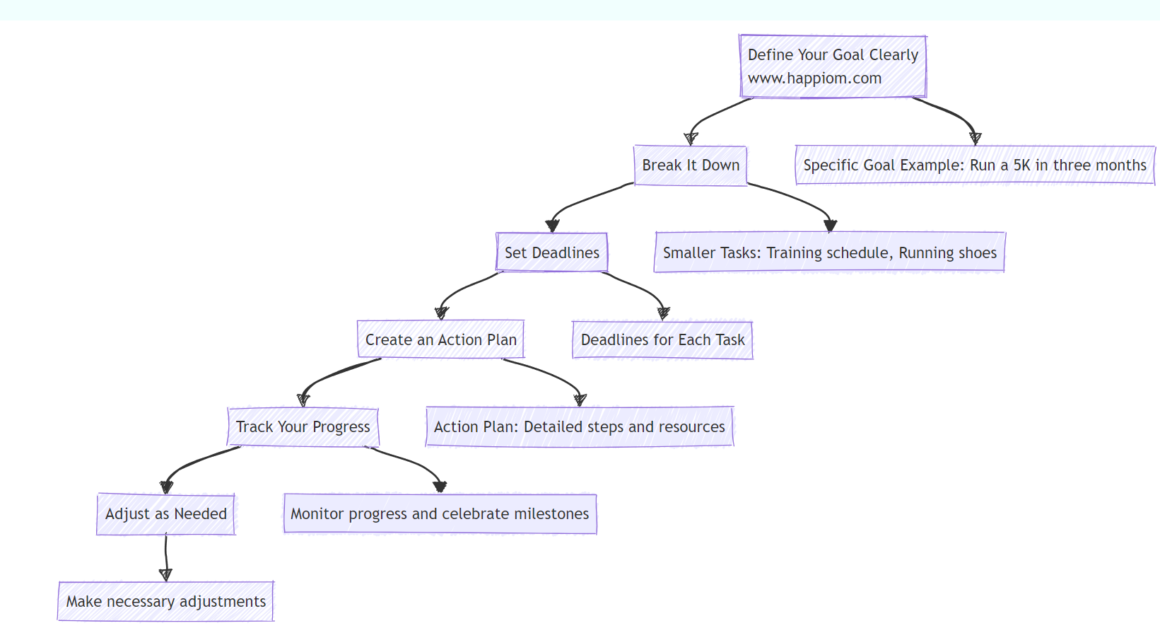Setting and achieving time-based goals is an effective strategy for turning aspirations into reality. By clearly defining what you want to accomplish and breaking it down into manageable tasks, you create a clear path forward.
With deadlines and a detailed action plan, you can stay organized and motivated. Regularly tracking your progress allows you to celebrate milestones and make necessary adjustments along the way.
This approach not only helps you stay focused but also makes the journey toward your goals more structured and attainable.
Let’s see 6 detailed steps to help you set and reach your goals.
1. Define Your Goal Clearly
Start by figuring out exactly what you want to achieve. Instead of a vague goal like “I want to get fit,” be specific. For example, “I want to run a 5K race in three months” is clearer and more actionable. Clearly defined goals help you know exactly what you’re aiming for and make it easier to create a plan.
- Tip – Use the SMART criteria—Specific, Measurable, Achievable, Relevant, and Time-bound—to help refine your goal.
2. Break the Goal into Smaller Tasks
Once you have a clear goal, break it down into smaller, manageable tasks. For running a 5K, your smaller tasks might include creating a training schedule, buying running shoes, and gradually increasing your running distance each week. This step makes your goal less overwhelming and helps you track your progress more easily.
- Tip – List these tasks in the order they need to be completed and set deadlines for each one to stay on track.
3. Set Deadlines
Assign a deadline for each task and for the overall goal. For example, if you want to run a 5K in three months, set weekly milestones for your training. Deadlines help you stay focused and create a sense of urgency, which keeps you motivated.
- Tip – Make sure your deadlines are realistic. Setting too tight a deadline can lead to frustration, while setting one that’s too loose might make you procrastinate.
4. Create an Action Plan
Develop a detailed plan outlining how you’ll complete each task. For example, your action plan might include a specific running schedule, meal plans for better nutrition, and regular check-ins to assess progress. This plan serves as a roadmap to guide you through the process and ensure you’re making steady progress.
- Tip – Include any resources or support you might need, such as a running group, fitness apps, or advice from a trainer.
5. Track Your Progress
Regularly monitor your progress to see how you’re doing. Keep a journal or use an app to record your workouts, note improvements, and reflect on any challenges you face. Tracking helps you stay accountable and allows you to make adjustments if something isn’t working as planned.
- Tip – Celebrate small victories along the way to stay motivated. If you hit a milestone, reward yourself with something you enjoy.
6. Adjust as Needed
Be flexible and ready to adjust your plan if necessary. Life can be unpredictable, and you might face obstacles or realize that your initial plan wasn’t perfect. If you encounter setbacks, reassess your goals and make changes to your action plan. For instance, if an injury prevents you from running, you might switch to a different form of exercise until you’re back on track.
- Tip – Stay positive and view adjustments as part of the process rather than failures. Adaptation is a key part of achieving any goal.
The following flow chart clearly shows the steps involved:

Summary of how to set and achieve time-based goals
- Define Your Goal Clearly – Be specific about what you want to achieve. For example, instead of “get fit,” say “run a 5K in three months.”
- Break It Down – Divide your goal into smaller, manageable tasks. For example, create a training schedule and buy running shoes.
- Set Deadlines – Assign a deadline for each task and for your overall goal to stay on track and motivated.
- Create an Action Plan – Outline how you’ll complete each task and gather any resources or support you need.
- Track Your Progress – Regularly check how you’re doing, keep a record, and celebrate small achievements.
- Adjust as Needed – Be flexible and make changes to your plan if things don’t go as expected.
Using these steps, you can set realistic time-based goals and create a structured plan to achieve them. Remember, the journey to reaching your goals is just as important as the destination.
Stay focused, be patient, and keep pushing forward!